Menu
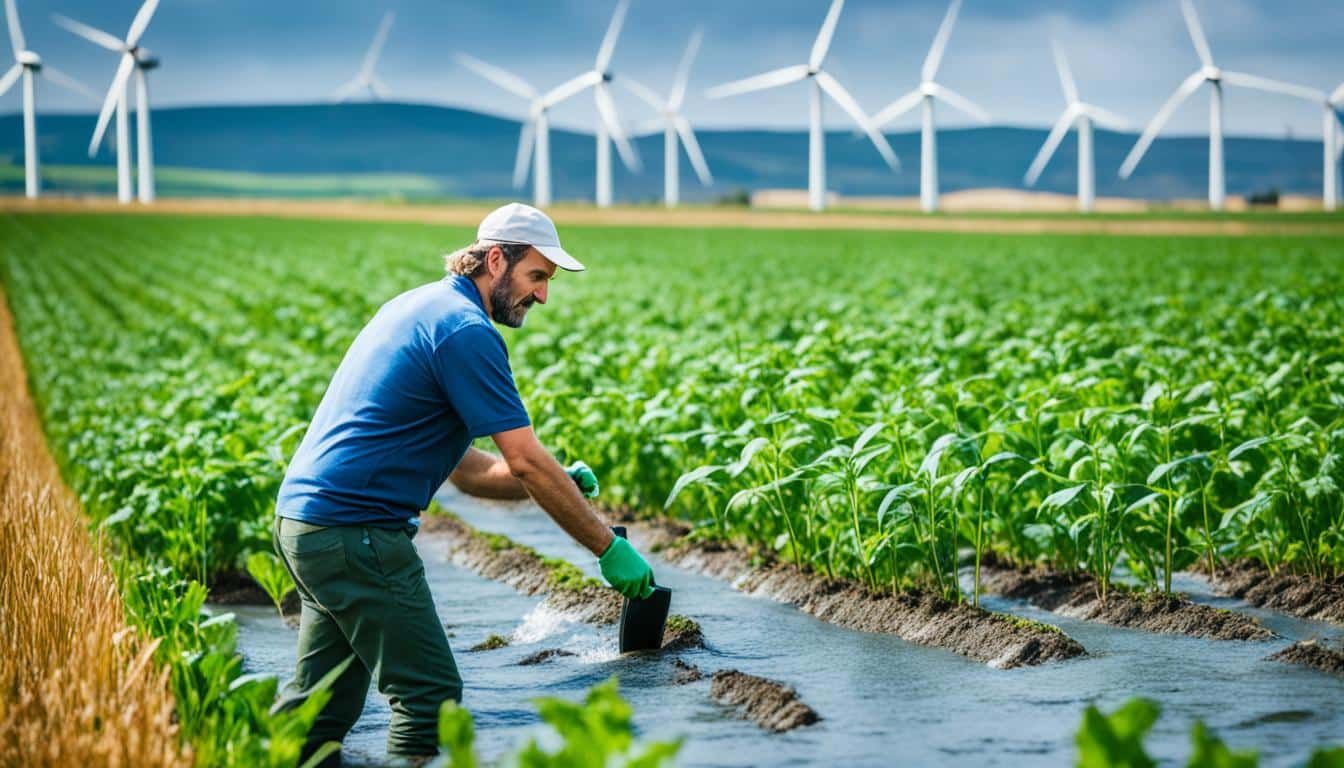
Unsustainable farming costs the world about $3 trillion every year. This makes moving to sustainable farming very urgent. Sustainable farming finds ways to work with nature while meeting human needs. It includes different methods like regenerative agriculture and permaculture. These aim to renew the natural resources our farming depends on.
Sustainable farming uses much less energy and creates fewer greenhouse gases than traditional farming. It keeps our planet safe, helps farm incomes, and makes farming more efficient. This benefits everyone, from farmers to all of society.
Also, by supporting more plant and animal life, sustainable farming helps us stay healthy. It also builds stronger economies and helps avoid costs from environmental damage. This includes making us better prepared for diseases like COVID-19. So, it’s not just about nature. It’s also key for our health and wealth.
Sustainable farming, or environmentally friendly agriculture, is all about keeping our planet healthy. It makes sure we can grow food and use resources without harming the earth. It uses smart ways to plant and raise animals without damaging nature. This is according to U.S. Code Title 7, Section 3103. Sustainable agriculture aims to feed us, keep the planet healthy, use resources well, and make life better for farmers and everyone else.
This way of farming brings together several techniques that help nature. For example, growing different crops together makes the soil better. This increases soil fertility by 15-30% over just growing one crop. Adding cover crops also stops soil from washing away and puts important nutrients back, helping the land stay good for growing food for many years.
Not digging the soil too much, known as no-till or reduced-till farming, cuts down soil loss by 50-90%. It shows how farming gently with the earth is key. Also, having both animals and crops on a farm can make it 10-20% more productive. This mix of farming activities proves that everything in the farm is connected. It makes the whole farm better and able to keep going.
Using integrated pest management (IPM) means using less chemicals to control pests. It can lower pesticide use by 30-50%, helping the environment and keeping our food safe. IPM fits in well with environmentally friendly agriculture by lessening bad effects on nature without losing crop health.
Sustainable farming isn’t just good for the planet; it’s a win for farmers, too. For example, growing trees with crops, called agroforestry, can boost a farmer’s income by 10-20%. Also, leaving some parts of the farm less used can cut down unhealthy runoff and boost wildlife. Together, these methods make a farm stronger and lasting.
In the end, sticking to sustainable farming practices can eventually raise crop amounts by 20-30%. This shows that these ways are not just good for the planet. They also keep farming healthy for the future. It helps farmers today and their families in the long term.
With a growing world, sustainable farming is a true hope. It brings advantages in many areas. These include taking care of nature, making money, and helping society.
Sustainable farming makes a big difference for the planet. It uses methods that are good for the Earth. This includes organic farming and looking after the soil. These methods reduce how much energy we use and the gases we put in the air.
Biodiversity is also helped. This means more plants and animals can live well. So, the world gets a better mix of life. This is a big plus compared to traditional farming.
This kind of farming is also smart for our wallets. It doesn’t cost as much as people might think. In fact, it can save money in the long run. Organic farms can produce more food over time. This means more money and jobs, especially in poorer areas.
It’s good for local businesses. It helps smaller farmers make a living. Plus, it means we don’t use up resources that won’t come back.
For people, sustainable farming brings many good things. It makes food fairer for everyone. It pulls communities together by working towards a common goal. Everyone gets better, healthier food to eat.
This way of farming is not too hard to start. You can do it on a big or small farm. It fits the needs of different places.
These benefits show that sustainable farming is key for a bright tomorrow.
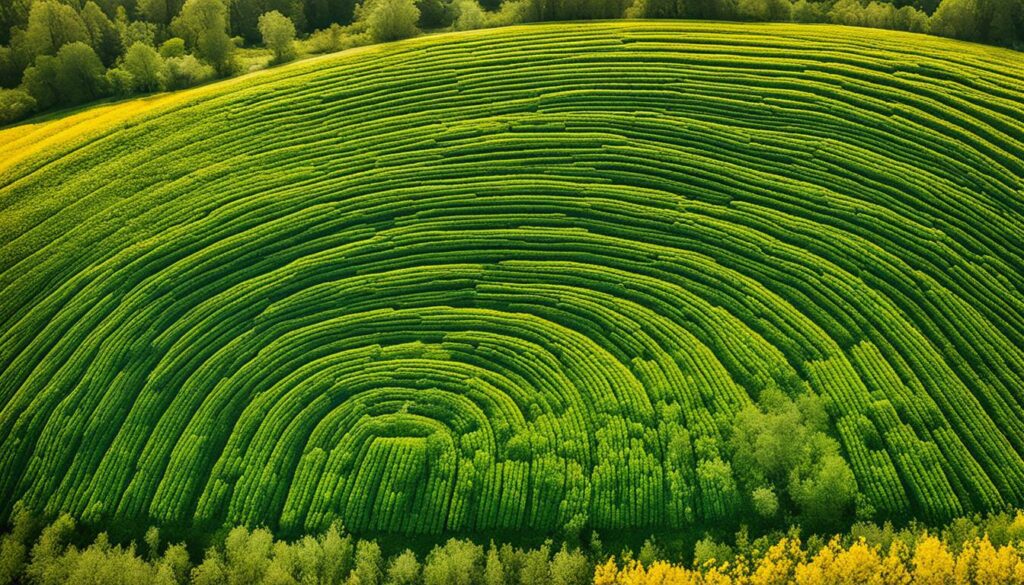
Using good crop rotation is key for keeping the soil healthy long-term and improving how we farm. This old method brings many benefits to farming today.
Crop rotation is vital in lessening soil erosion. By changing the kinds of crops planted, we strengthen the soil against wear and tear. For example, growing beans, then tomatoes, and finally sweet corn not only boosts the amount of crops but also cuts down on soil loss. Different plants help hold the soil together, protecting it from being washed or blown away.
Crop rotation is important because it stops pests and diseases from taking over. The practice of planting corn followed by soybeans in the U.S. Midwest is a good example. It interrupts the pests’ and diseases’ usual life cycles, letting farmers use less nitrogen while growing corn. Rotating tomatoes, sweet corn, okra, and beans on small farms also helps fight off pests and diseases. This creates a better environment for the soil to remain healthy. In dry places, the strategy of growing wheat and then leaving the land bare allows the soil to recover and keeps pests at bay.
Crop rotation boosts the soil’s nutrients, making it more fertile. Beans are often used in rotations to add nitrogen to the soil naturally. The plan of planting corn, then soybeans, followed by wheat, takes this a step further with cover crops like clover or rye. This enriches the earth even more. Such rotations prevent the soil from losing too much of any specific nutrient. Thus, they create a fertile ground that’s perfect for growing crops steadily over time.
Planning crop rotation carefully means keeping detailed records of what is planted where and when, and noting any pest problems. Research has shown that using different crop rotations doesn’t just increase the amount of food we grow. It also cuts down on the gases that are causing climate change, and it makes the soil healthier.
Organic farming is a key part of being eco-friendly. It helps the environment and our health. This method doesn’t use synthetic fertilisers and pesticides. Instead, it uses ways that help the land and water stay healthy. More people are choosing non-GMO products, so the use of organic farming is growing, up by 1.6% each year. Let’s look at why organic farming is important.
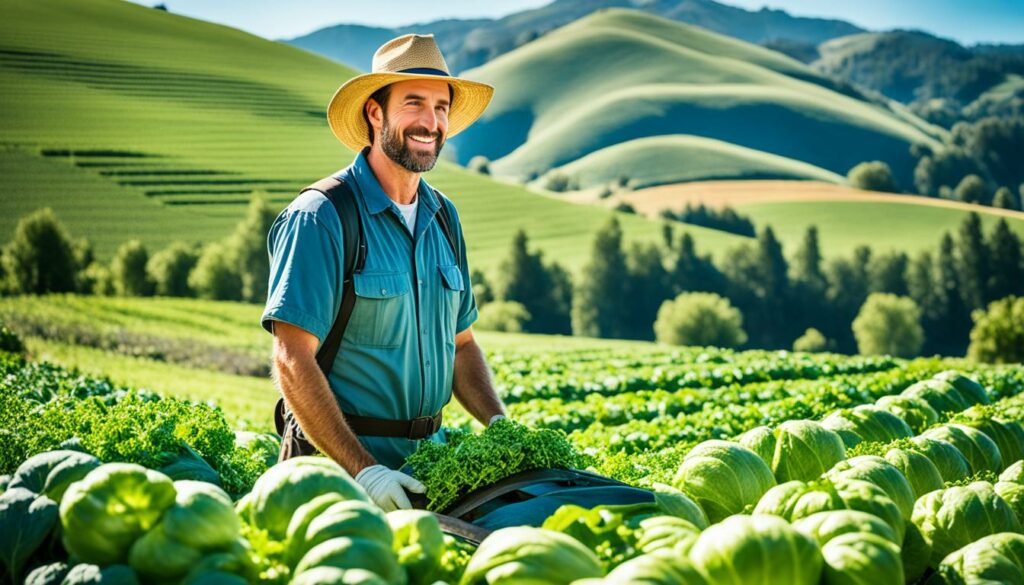
Organic farming begins with not using synthetic inputs. Farmers need a special certification to be called organic. This means they follow strict rules against GMOs and artificial fertilisers. They use natural things like manure and compost instead.
Helping nature by promoting many different plants and animals is a big deal in organic farming. Techniques like buffer zones and changing which crops are grown in a field each year help a lot. They keep the soil healthy and reduce the number of pests and diseases. Organic farmers don’t use sewage sludge, keeping our world cleaner.
Organic farming is great for making the soil and water better. It avoids chemicals, making the soil a good place for plants. This also stops chemicals from polluting water. Healthy animals make healthier food and a better planet.
| Aspect | Organic Farming |
|---|---|
| Synthetic Inputs | Avoided |
| Biodiversity | Promoted |
| Soil and Water Quality | Improved |
| Use of GMOs | Prohibited |
Conservation tillage is key to sustainable farming. It uses methods that disturb the soil less. This boosts soil health and cuts down on erosion. Placing crop leftovers on the ground is a key part of this. It helps the earth in many ways. It traps carbon, which is good for the atmosphere. Plus, it helps manage how water moves in the ground.
At least 30 percent of the soil should be covered by old plant parts. This cuts the amount of soil washed away by water. For protection against wind, you need 1000 pounds of crop leftovers per acre when it’s critical. Using methods that don’t move the soil a lot, like not tilling or tilling in ridges, also help.
Conservation tillage helps water soak into the soil better. It does this by disturbing only small parts of the ground. Doing this improves the ground’s ability to hold onto water. This is good for the plants. It also boosts the amount of natural stuff in the soil. Using the right tools and machines to plant and spread old plant parts on the ground makes this process work even better.
Conservation tillage is really good at keeping carbon in the ground. It avoids disturbing the soil too much. This helps keep old plant parts on the ground. It makes the soil’s structure better and catches carbon. Methods like not tilling and tilling with a covering cut down on how much we dig up the ground. This makes the soil stronger and more alive. It’s a big help in fighting climate change.
| Method | Erosion Control | Water Management | Carbon Sequestration |
|---|---|---|---|
| No-Till | High | Excellent | Very High |
| Strip-Till | Moderate | Good | High |
| Ridge-Till | Moderate | Good | Moderate |
| Mulch-Till | High | Excellent | High |
Keeping water use in check is crucial for farms to last. A big challenge is expected soon – a 40% drop in water by 2030. Farming soaks up 85% of water in the U.S. This makes saving water vital.
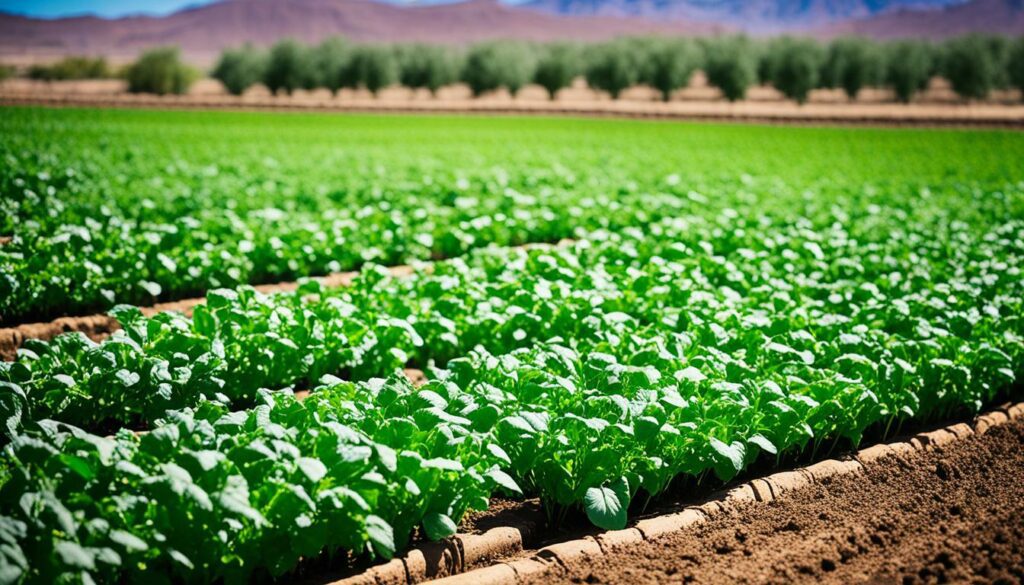
Drip irrigation is top-notch, saving as much as 80% more water than old methods. It cuts down on water disappearing into the air or soil. Instead, it gets water directly to the plant roots. With a place like Nevada needing lots of water for its farms, smart systems are a big help.
In western areas, water can leak away from canals by up to 10%. This shows the need for better ways. Using mulch stops water loss by keeping the soil damp. Moisture sensors in the soil stop it from getting too soggy, saving water at the same time.
Rainwater systems are also key. They cut the need for fresh water for plants, making sure there’s enough water for the future. Then there’s high-tech. Tools like smart sensors and drones guide farmers to use water smarter, leading the way to a water-wise future.
Looking at the big picture, ignoring water dangers might cost over $425 billion. This warning tells us to check how safe our water supplies are for farming.
Small family farms stand to win big with these water-saving tricks. By adopting sustainable ways, farms can make the most of water. This leads to a future with less worry about not having enough water, where our use of resources is smart.
Agroforestry combines farming with growing trees, and it’s full of benefits. It helps the soil, catches carbon, and makes better climates for farms. This method isn’t just good for nature. It also makes farms stronger and more profitable.
Agroforestry is great for soil health. Trees make the soil better, meaning it keeps more nutrients and erodes less. What’s more, it can boost soil carbon by a third. This makes the soil more alive and better for growing things.Turning fields into agroforestry raises soil carbon by 10%, keeping the land productive.
Agroforestry is key in trapping carbon, holding about 3.5 tons per hectare each year. This is more than standard farming does. It’s a big help in fighting climate change. With more trees, the farm’s carbon footprint shrinks, supporting global climate goals.
It’s aligned with the USDA’s green strategy, which aims for cleaner air and fewer climate issues.
Agroforestry helps create better climates for crops. Trees shelter plants from wind and keep temperatures and moisture moderate. They can boost crop yields by up to 50% by creating stable conditions.
This shields farms from sudden changes in the economy or the weather, making them more robust and stable.
“Agroforestry practices can help diversify production systems for farmers and ranchers, benefiting environmental stewardship and enhancing profitability.” – USDA
| Benefits of Agroforestry | Impacts |
|---|---|
| Improved Soil Fertility | Increases soil organic carbon by 34% |
| Carbon Sequestration | Sequesters 3.5 tons of carbon per hectare per year |
| Enhanced Crop Yields | Potentially increases by 50% |
| Creating Microclimates | Protects against weather extremes and improves resilience |
| Economic Well-being | Provides jobs and enhances economic conditions in rural areas |
Agroforestry is a well-rounded approach to farming. It takes care of the environment, the soil, and the economy. By adding trees to farming, it boosts land health and performance. This ties in with big ecological and economic plans, ensuring a better future for agriculture.
Integrated Pest Management (IPM) is all about farming with the environment in mind. It uses many ways to control pests without a lot of pesticides. This can reduce harm to the environment and make farms more sustainable.
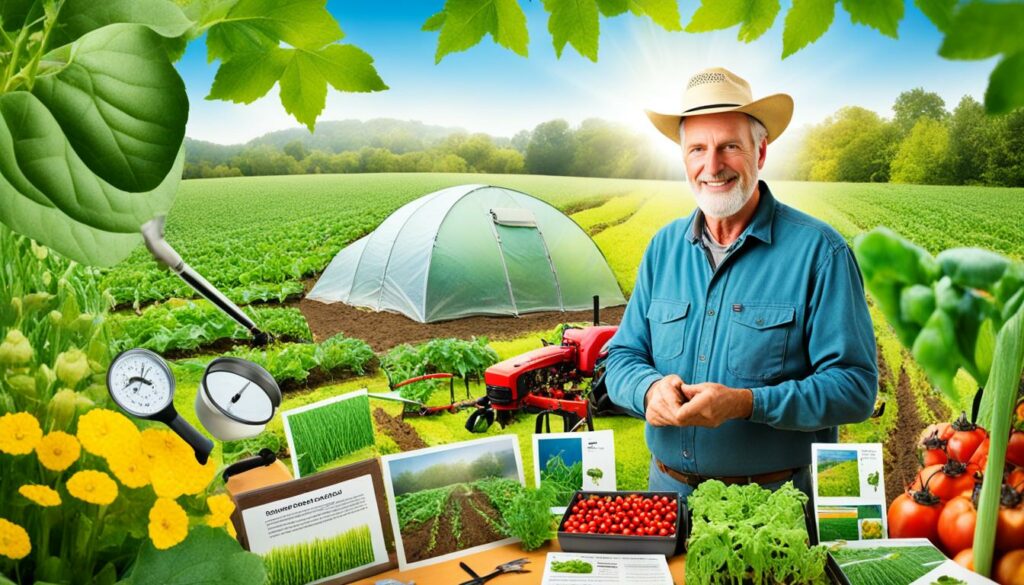
The UC Agriculture and Natural Resources Division started the UC Statewide IPM Program in 1979. At first, it focused on just a few crops like alfalfa and almonds. Now, it helps with pest control for over 65 crops.
IPM mixes different ways of pest control like using helpful bugs and changing how crops are grown. Using natural enemies of pests keeps the ecosystem healthy and cuts down on chemicals.
IPM combines different strategies such as changing crops each season, using traps, and using chemicals as a last resort. This ensures pests are managed well.
In the 1940s, UC researchers helped come up with these smart pest control methods. By the 1990s, more focus was put on not using as much pesticide. Instead, they looked at using more natural and cultural ways to keep pests at bay.
The UC IPM website gives up-to-date info to help with pest control decisions. It’s a joint effort with UC schools, Extension services, and others. Together, they work on practical ways to use IPM.
Choosing IPM means a better way to deal with pests that’s good for the planet. It means less harmful chemicals in our food and surroundings. It’s also good for farmers, as it cuts costs and improves what they grow. IPM gives farmers the tools to choose the best solutions for their land.
IPM is more than just a method; it’s a comprehensive approach to managing pests. It stands for a new, balanced way to do agriculture that’s good for both farming and the Earth.
Cover crops are essential for sustainable farming. Their popularity has grown in recent years. In 2017, 15.4 million acres were planted with them, a 50% increase in just five years. This shows that farmers and agriculture experts are recognizing their benefits more.
Cover crops help prevent soil erosion. They keep the soil steady and lessen runoff from heavy rains. This action is key to fighting soil damage, which is common in the Northeastern United States. They also fight soil compaction, making the ground better both near the surface and deep down.
Cover crops are also vital for fixing nitrogen in the soil. Legume cover crops can add 50 to 150 pounds of nitrogen per acre, depending on how well they grow. Other cover crops help manage nitrogen too, taking in 30 to 50 pounds per acre when planted in autumn. They can also grab up to 150 pounds per acre if a lot of nitrogen was left from earlier crops or manure.
The financial gains of using cover crops are significant. After five years, farmers saw a 3% rise in corn yield and a 4.9% rise in soybean yield. These numbers were even higher during the drought of 2012, with a 9.6% corn increase and an 11.6% soybean rise. Using cover crops for the long term improves soil health, which is critical for ongoing farm success.
The benefits of cover crops have been known for a long time. The ancient Romans valued crops like lupine and vetch. George Washington himself promoted their use in 1786. Cover crops make the soil better, enhancing fertility and structure. This method allows for more crops without needing harmful chemicals.
| Metric | Value |
|---|---|
| Acres planted in 2017 | 15.4 million acres |
| Increase in cover crops from 2012 to 2017 | 50% |
| Farms using cover crops (2012-2017) | 15.2% increase |
| Nitrogen fixation by legumes | 50-150 lbs/acre |
| Nitrogen uptake by non-legumes | 30-50 lbs/acre |
| Increase in corn yield | 3% over 5 years |
| Increase in soybeans yield | 4.9% over 5 years |
Therefore, cover crops underpin sustainable farming. They boost soil health, fix nitrogen, and save money. Embracing them ensures future success in farming, both in terms of the environment and the economy.
Using renewable energy is key for the future of sustainable farming. More farms are using solar panels, wind turbines, and biogas digesters. These change how farms work. They cut down on using oil and lower pollution.
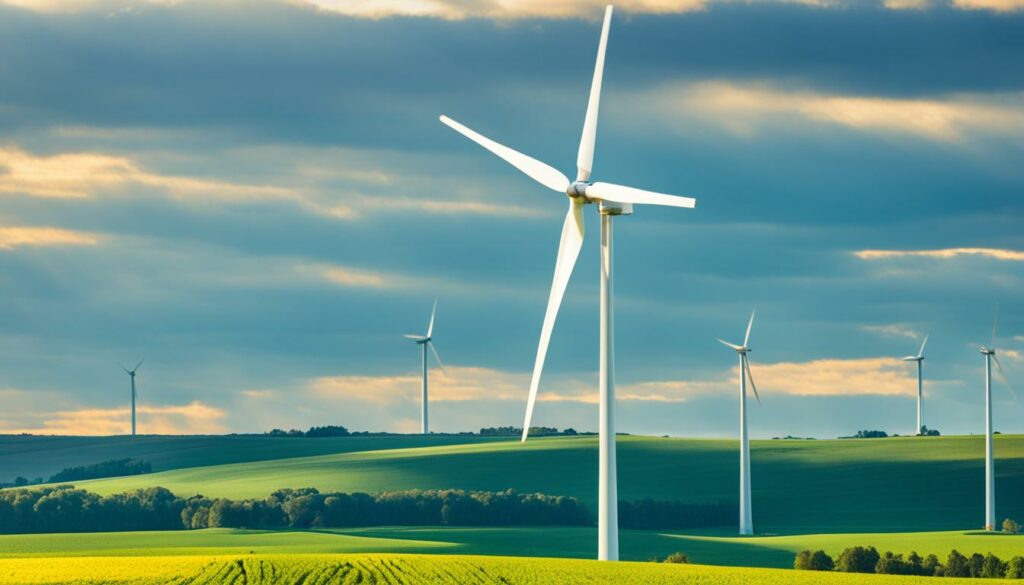
Solar energy is easy to use for farms. It helps cut down large electric bills. With the 30% off from the ITC, solar system costs lessen. This makes it cheaper for farmers to run their farms.
In windy areas, wind energy is great. Wind turbines turn wind into electricity. They work all day if the wind is strong enough. The REAP program helps more farms use wind power by giving extra money.
Biogas is a green fuel made from waste. It means farms use less oil. The USDA helps farms make biogas. This program cuts greenhouse gas pollution.
Large farms can get a lot from these green technologies. They can power their own water pumps and even sell extra power. This changes farming into a less polluting and more effective industry.
Working on sustainable agriculture’s challenges and misconceptions is tough. One big issue is environmental harm. It’s worse because 70% of the water is used in farming. And, only 12% of the land is good for farming, highlighting the need for careful land use.
It’s crucial to fight this harm with smart farming and land use. Things like soil erosion hurt farms, making it hard to grow food. By using conservation methods, we can make farming more sustainable.
Encouraging urban planning to integrate green spaces can bridge the gap between urban and rural areas, easing the competition for resources like water.
But, people still think of farming as an old, simple job. This isn’t true. Today, farmers use high-tech tools to grow our food. In the U.S., most farms are run by families, many being small farms. This shows that farming is modern and smart.
Modern farming methods like precision agriculture are making a positive change. Practices such as low- and no-till farming help use water and fertilisers better. They also reduce harm to the environment, changing the image of farming.
Consumers are starting to support farming that heals the land. But, not many people know about it yet. Luckily, farmers have always used technology to improve their work. These new methods help farm better and protect the earth.
| Challenge | Impact | Mitigation |
|---|---|---|
| Environmental Degradation | Reduced soil fertility, freshwater depletion | Implementing conservation techniques |
| Urban Competition for Resources | Strain on local farms | Urban planning with green spaces |
| Misconceptions About Farming | Public unawareness, slow adoption of innovations | Education and awareness initiatives |
Sustainable farming in developing countries is key. It lets them get better prices for crops, raising farmers’ incomes. This ties into the Sustainable Development Goals and our aim for Zero Hunger.
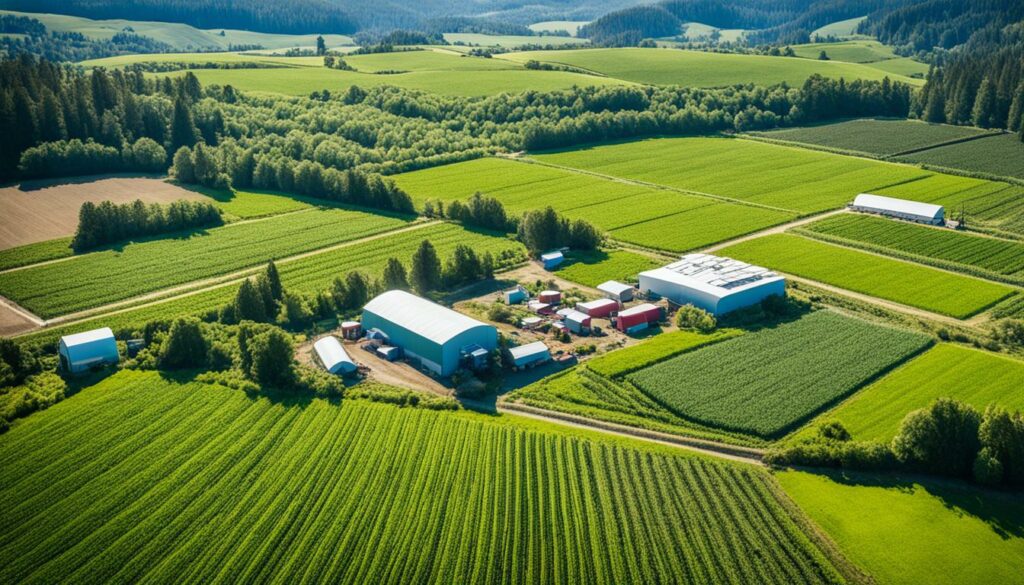
Moving to sustainable ways brings both economic and green gains. For example, it cuts energy use by 56% each year for every crop and drops greenhouse gases by 64% per hectare. It also boosts biodiversity more than traditional farming.
These methods also create more jobs in food production, up to 30% more. They also reduce food waste, helping the planet. Just cutting waste could lessen the world’s carbon pollution by 8-10%. It shows how closely helping the environment is linked to ending Zero Hunger. What’s more, sustainable farming can raise crop production by 80% in just four years, proven in some developing countries.
Growth in farming fights poverty better than other sectors. In places where farming is key to the economy, like developing countries, green farming could lead the way out of poverty.
Here are some eye-opening figures:
| Aspect | Impact |
|---|---|
| Energy Use | 56% less energy per unit produced |
| Greenhouse Gas Emissions | 64% fewer emissions per hectare |
| Job Creation | 30% more jobs due to labour-intensive nature |
| Crop Yields | 80% increase within four years in developing countries |
| Food Waste Reduction | 8-10% global carbon emission reduction |
I push for more people to know about this and for better rules to help small farmers go green. The UN Environment Programme is leading the way with advice on how to better govern in the food industry. This makes reaching the Sustainable Development Goals and ending Zero Hunger more possible.
Government policies are very important for creating long-lasting food systems. The Agriculture Improvement Act of 2018, also called the current farm bill, was passed in December 2018. It covers many areas like commodities, conservation, trade, and nutrition. This shows how deep the government is involved in agriculture.
This bill includes the Local Agriculture Market Program, Farming Opportunities Training and Outreach, and the Organic Agriculture Research and Extension Initiative. They get less than $5 billion out of the $428 billion budget for five years. More money is needed for future efforts towards sustainable farming.
When the farm bill is renewed, it goes through several steps. There’s reauthorisation, appropriations, implementation, and oversight. All of this includes debates and hearings in the House and Senate Agriculture Committees. The process is complex but ensures the laws are careful and fair.
The government also supports eco-friendly farming. It’s important to make farming methods that save costs and the environment. For example, policies should reduce harmful farming methods that hurt the earth and use up a lot of water. Experts say farmers need help from the government to switch to more eco-friendly ways.
Every country also works together through groups like the UNEP. They have programmes focusing on sustainable food systems and fighting food waste. These efforts encourage countries to work together for a greener future. They show how important it is to join hands for the planet.
| Farm Bill Phase | Description |
|---|---|
| Reauthorisation | Reevaluation and renewal of the bill’s programmes and initiatives. |
| Appropriations | Allocation of funds to specific programmes under the bill. |
| Implementation | Execution of the policies and distribution of allocated resources. |
| Oversight | Monitoring and evaluation of the programme outcomes and effectiveness. |
The government can bigly affect food systems by backing up eco-friendly farming. Rules from public offices can make businesses put money into green farming. This helps the planet and people, too.
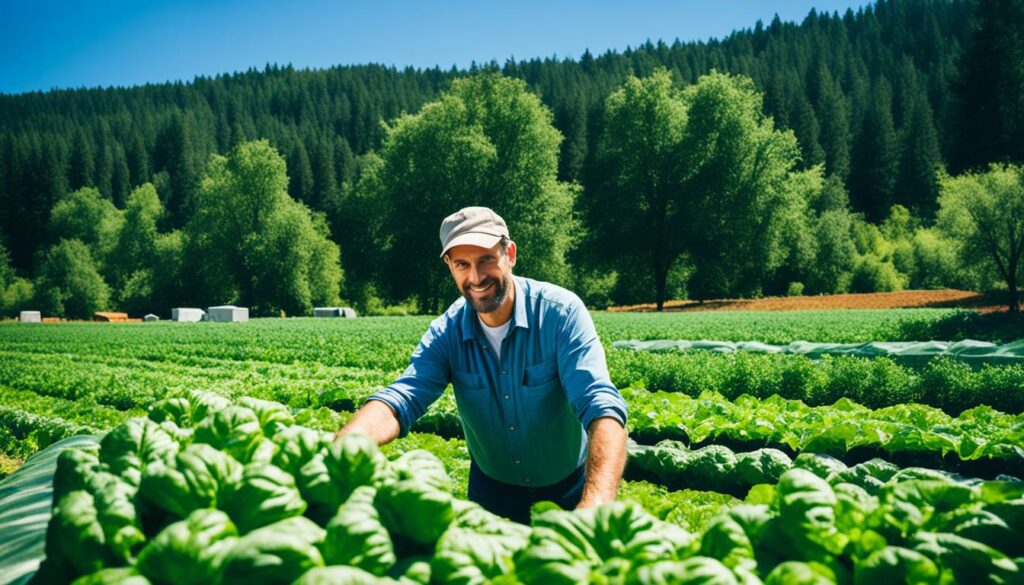
Supporting sustainable agriculture benefits us all. Choosing products from local and organic farms helps a lot. It reduces plastic pollution, which can harm our environment. These farms care a lot about the planet and try to use less plastic. This is what true sustainable food systems are all about.
To help, we should cut down on food waste. Only buy what you need. This simple step can save money and protect the environment. It also helps make food production more sustainable.
Choosing plant-based foods is also great. It uses fewer resources than making food from animals. Plus, choose items that aren’t wrapped in plastic. Or buy in bulk to use less single-use plastic. This helps protect our oceans and the creatures in them.
Standing up for what we believe in is powerful. Join groups that make a difference. Sign petitions and talk to your leaders. Together, we can make our food system more sustainable. We can change the rules to support the Earth more.
| Reasons | Actions |
|---|---|
| Minimise Plastic Pollution | Choose plastic-free products, buy in bulk |
| Support Local and Organic Farms | Buy from local markets, prioritise organic products |
| Advocate for Policy Changes | Join advocacy groups, sign petitions |
| Reduce Food Waste | Purchase only necessary quantities, compost leftovers |
| Opt for Plant-Based Foods | Incorporate more plant-based meals |
We can also teach others about the benefits of plastic-free farming. This can encourage many to take action. By making careful choices, we can support a sustainable agriculture. Together, we can help create a strong, Earth-friendly food system.
In ending our talk on sustainable farming, it’s clear that eco-friendly agriculture is vital. This approach brings many benefits by working with nature. It uses things like crop rotation, saving water, and renewable energy.
It’s also about working together to find new ways to farm. Both science and social studies help in this. With help from organisations like SARE, farmers and researchers can get new info. This helps them do better and sustainable farming.
In the last forty years, sustainable farming has really taken off. It supports the planet, makes money, and treats people fairly. This new way of farming is all about using science and new values. It encourages farms to be strong, change when needed, and to welcome variety. This way, we can see how farming is getting more sustainable over time. This is good for looking after the Earth and making sure we have enough food.
Sustainable farming uses eco-friendly methods. This includes crop rotation and permaculture. It aims to keep the environment safe while growing food.
It lowers energy use and pollution. It also helps plants, animals, soil, and water to stay healthy. This creates a vibrant ecosystem.
Organic farming grows food without harmful chemicals. It boosts wildlife, stops pollution, and improves soil and water.
Crop rotation stops soil damage and fights pests. It also keeps the soil full of nutrients. This leads to a stronger, healthier ecosystem.
Conservation tillage keeps the soil safe, cuts erosion, and saves water. It also traps carbon. This helps fight climate change.
Drip irrigation and rainwater collection are key. They save water and balance the local ecosystem. This supports a sustainable future.
Agroforestry helps the soil by planting trees among crops. It boosts biodiversity and fights climate change. It also protects farmland from harsh weather.
IPM fights pests with natural methods first. It cuts down on pesticide use. This helps the environment and our health.
Cover crops stop soil loss and feed the soil. They also help with weed control naturally. This keeps the farm healthy without chemicals.
Renewable energy reduces pollution from farming. It uses things like solar power. This helps farms support the planet.
Many don’t know how farming affects the Earth. Laws to protect the environment are not enough. Also, not everyone knows about or demands eco-friendly farming.
It can grow more jobs and improve incomes in poorer countries. It also helps meet world goals like No Hunger. This makes sustainable farming good for these places.
Governments can help farmers sell their produce. They can also change rules to be more green. Programs supporting sustainable food help the world’s food systems.
Buy foods that are grown sustainably. Eat a variety of foods and prevent waste. Learn about good farming. These simple acts make a big difference.